Launch of 2021 Report on Yangtze River Economic Belt’s Green and Innovative Development Index and the 4th High-End Forum on Yangtze River Economic Belt’s Development
2021-12-26 IMIOn November 27, the 2021 Report on Yangtze River Economic Belt’s Green and Innovative Development Index was released. Meanwhile, the 4th High-End Forum on Yangtze River Economic Belt’s Development was held in Beijing. The two events weresponsored by the Yangtze River Economic Zone Research Institution of Renmin University of China (RUC), National Academy of Development and Strategy of RUC and School of Finance of RUC, and wereorganized by the International Monetary Institute (IMI) of RUC.
In the morning, Liu Yuanchun, Vice President of RUC, moderated the session where the 2021 Report on Yangtze River Economic Belt’s Green, Innovative Development Index (the Report) was launched. Leaders, experts, researchers from China’s financial regulatory authorities, research institutes and the financial sector participated in the hybrid meeting.
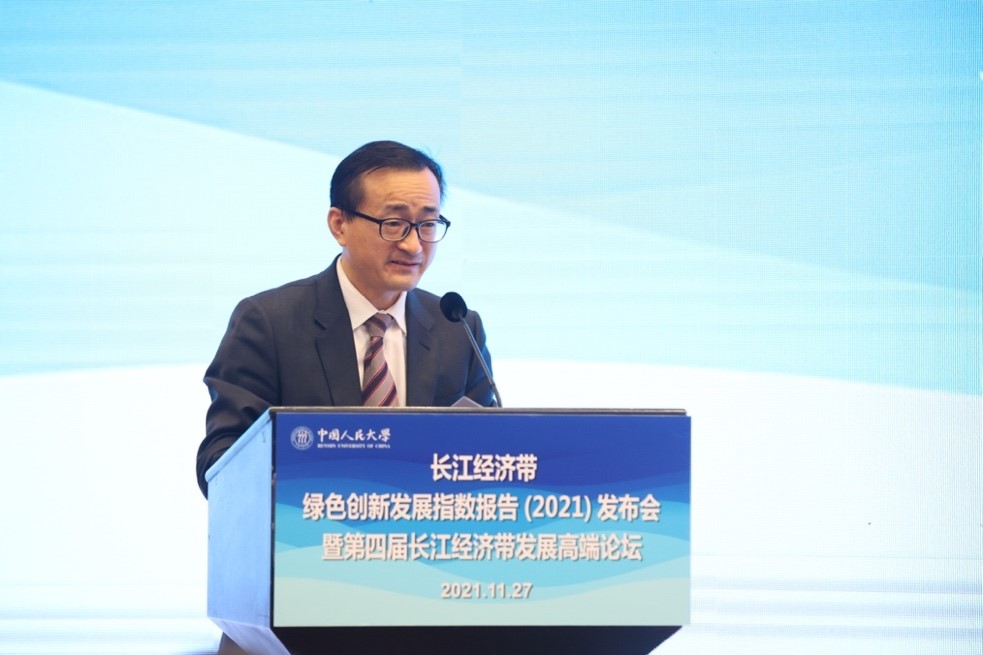
Liu Wei, President of RUC, and Liu Xinhua, Vice Chairman of National People’s Congress Financial and Economic Affairs Committee and former Vice Chairman of China Securities Regulatory Commission, respectively delivered speeches.
President Liu Wei first highlighted General Secretary Xi Jinping’sblueprintfor the Yangtze River Economic Belt and the importance of this area. According to him, the Report revolves around the philosophy of promoting innovation in green development and boosting green development through innovation. The Report evaluates the state of green, innovative development in different cities which the Yangtze River runs through based on two criteria of input on green, innovative development andoutput of green, innovative developmentconstructed by combining economic, innovative and environmental elements. Liu Wei concluded by summarizing the Report’s innovations. Firstly, the Report takes into consideration both innovation-driven development and green development. Secondly, it incorporates a measure of innovations’ commercialization. Thirdly, the index of the output of green, innovativedevelopment iscalculated based onan array of indicators which are highly logical.
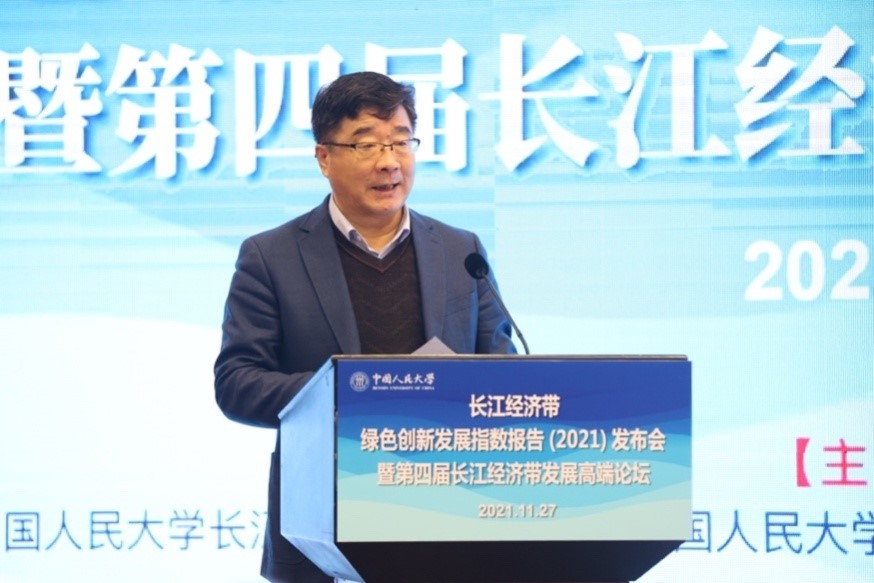
Chairman Liu Xihua called attention to the importance ofgreen development in China’s strategic layout and the significance of finance in buttressing green development. He then pointed out that although China has made notable progress in expanding access to green finance and diversifying green financeproducts, it still needs to improve its mechanism via which funds can be channeled toward green developmentby drawing on international experience and considering national conditions. He concluded by illustrating how a reform and innovation synergy can be created from three perspectives of institutions and systems, market mechanism and product supply, therebyfacilitating green development and contribute to China’s “Dual Carbon” goals.

Li Yang, Member of the Chinese Academy of Social Sciences (CASS) and Chairman of the National Institution for Finance & Development, and Fang Cunhao, Deputy Secretary of Yibin Municipal Party Committee and Mayor of Yibin, respectively made keynote speeches.
Chairman Li Yang shared his insights into problems observed inthe integration and green development of the Yangtze River Delta from three aspects of contextual information, rural revitalization and low carbon development. It should be noted that the Yangtze River Delta’s economic growth is slowing down, its population is declining and aging, its urbanization is decelerating, and its pollution mobility is decreasing. These combined put the Yangtze River Deltaat adisadvantage.Li Yang contended that urban-rural integration benefits both urbanization and rural revitalization.Urban-rural integration consists of two aspects, namely equal access to public services and integration of the land market. The Yangtze River Delta is China’s most economically developed area with a relatively mature market system and should therefore make its due contributions to advancing urban-rural integration and eliminating the urban-rural gap. When it comes to the implementation of the green development strategy in the Yangtze River Delta, according to Li Yang,it should be noted that this strategy embracesawide variety of aspects andhas a long lifecycle with complex influence. Particularly, industries that will benefit or be harmed by this strategy should be identified at the very beginning so that targeted measures can be taken. Compensations shall be given to industries that are harmed, people who are affected should be relocated, and “problematic assets” shall be disposed of carefully. Only by addressing theseissues can steady green development in the Yangtze River Delta be achieved.
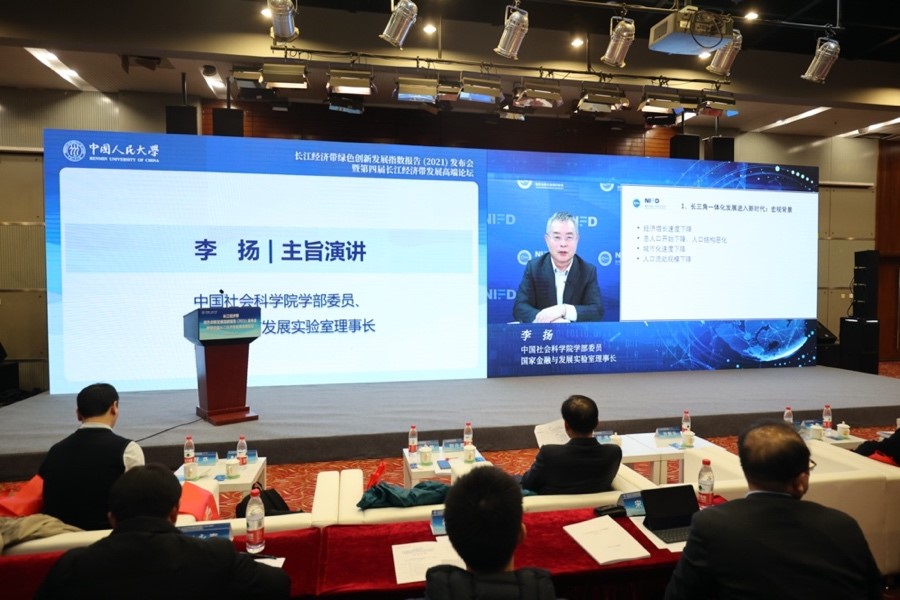
Mayor Fang Cunhao delivered a keynote speech entitled “Innovation-Driven Green Development—Accelerating the Building of Socialist ModernCentralCities for Different Regions in China”. He pointed out that located at the upper end of the Yangtze River, Yibin shoulders the responsibility of preserving the ecosystemof the upper Yangtze River. In recent years, guided by Xi Jinping Thought on Socialism with Chinese Characteristics for a New Era, Yibinhas been boosting innovation to foster new drivers of quality growth. One the one hand, the city puts ecological protection and green development in the first place and has progressed in ecological protection and pollution preventionand control. On the other hand, the city upholds education-underpinned and innovation-driven development and has made a breakthrough in building itself into a university town and a city of innovations and expediting industrial transformation and upgrading. Looking forward, Yibin will proceed with ecological protection, continue toinnovateand strive for green, low-carbon development, so as to facilitate the construction of socialist modern central cities for different regions in China.
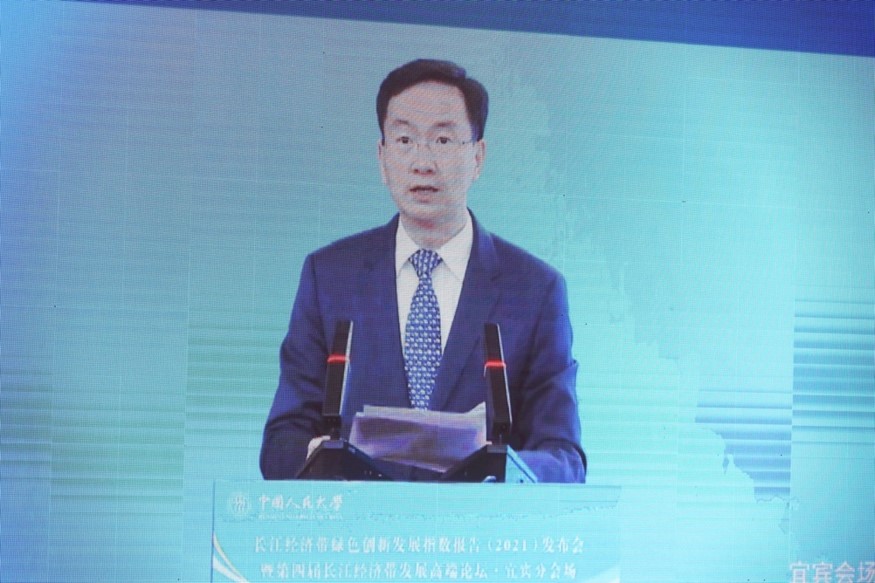
Later on, Zhuang Yumin, Dean of School of Finance,RUC, unveiled the 2021Report on Yangtze River Economic Belt’s Green, Innovative Development Index. Cheng Lian, Research Fellow at Institute of Finance & Banking, CASS and Director of the Editorial Department of Chinese Review of Financial Studies, Luo Rong, Deputy Director of the Scientific Research Department of Academy of Macroeconomic Research, National Development and Reform Commission, Ma Wenjie, Dean of Shanghai Institute of International Finance Center of Shanghai University of Finance and Economics, and Zhou Yueqiu, Chief Economist at Industrial and Commercial Bank of China, respectively commented on the Report. This session was moderated by Lin Chen, Head of National Academy of Development and Strategy, RUC.
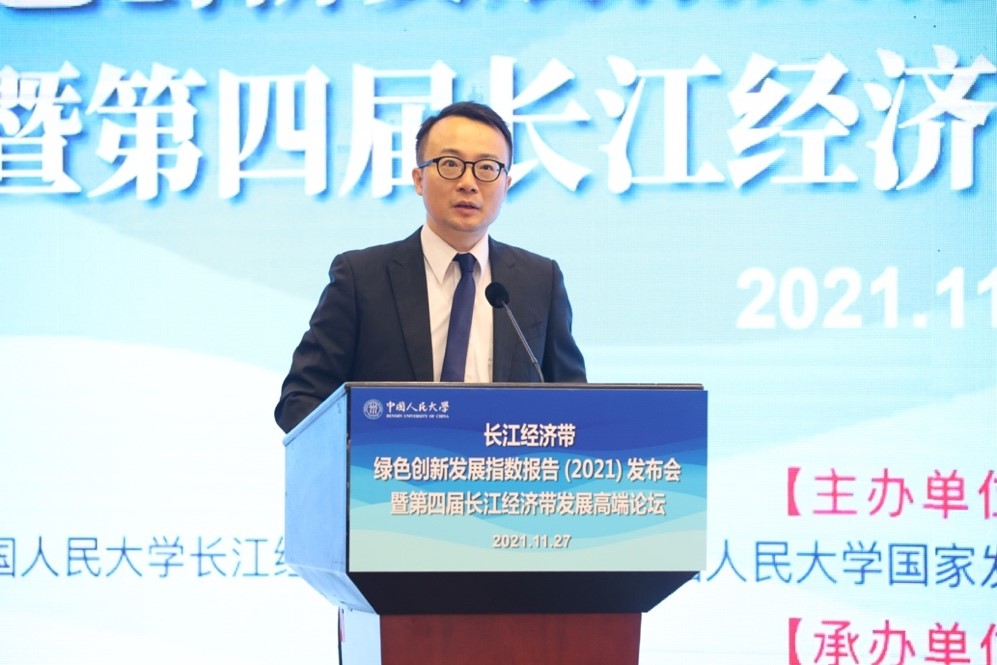
Dean Zhuang Yumin pointed out that the Yangtze River Economic Belt spans 11 Chinese provincial-level regions, covers eastern, central and western regions of China, and makes up 40 percent of the country’s population and economic output. The Report aims to implement General Secretary Xi Jinping’s Thought on Ecological Civilization and hisblueprint for the Yangtze River Economic Belt, put into practice China’s new development philosophy, and promote innovation in green development and boost green development through innovation, so as to promote high-quality development of the Yangtze River Economic Belt.Reflective of input on green, innovative development andoutput of green, innovative development, the Report selects two level Ⅰindicators, eight levelⅡindicators and 25 levelⅢindicatorsto develop and calculate the green, innovative development index, which can be used to assess the state of green, innovative development of 110 cities inside the Yangtze River Economic Belt and these cities’ competitiveness in green, innovative development. The Report analyzes these cities’ common problems and shortcomings in terms of their input on and output of green, innovative development and accordingly proposes policy recommendations including formulating policies, adopting technologies, encouraging innovation and overall consideration. This Report also enablesthe 110 cities to model themselves on their counterparts who fare well in green, innovative development.
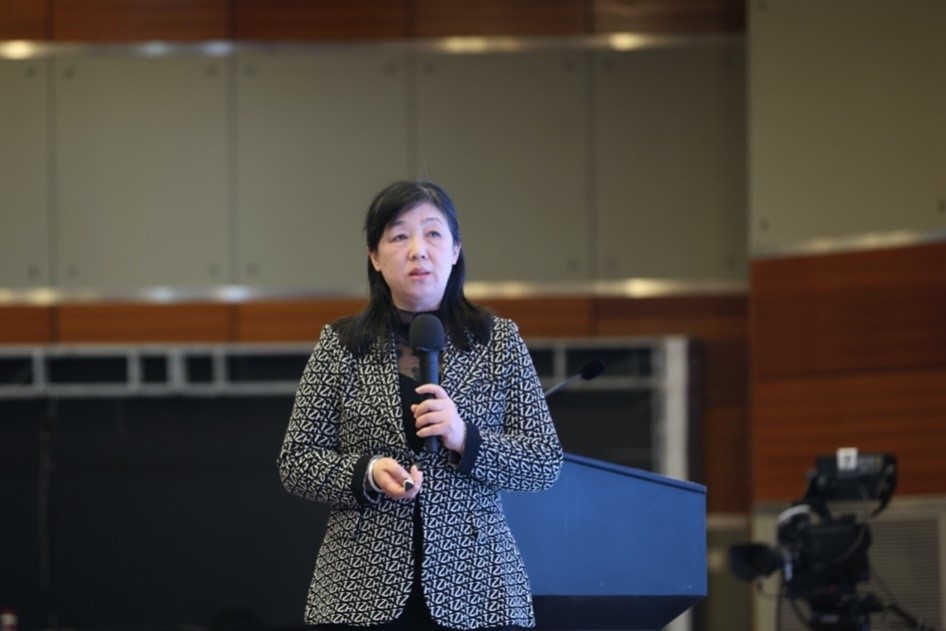
Research Fellow Cheng Lian first pointed out that the most common definition of “green” is quality lifewhere people are surrounded by abundant plants, whichmay not be lowcarbon. The second definition of “green”is about lowcarbon. For example, financial professionals would associate “lowcarbon” with carbon emissions and green risks. The third definition of “green” is sustainable development. The three definitions are somehow different and should be taken into consideration in analysis and practice. Cheng Lian also asserted that many green development reports still take GDP as an important measure when developing their own indices and thatthe measure of economic aggregate carries strong weight with China’s green developmentindex system. This system gives economically developed cities an advantage in the carbon emissions market andwoulddiscouragecitieswithlower GDP or lower per capita GDP from promoting green development. Cheng Lian concluded by suggesting that GDP’s weight in the green development index system should be lowered anda comparative index which compares cities of similar economic output can be constructed to incentivize cities.
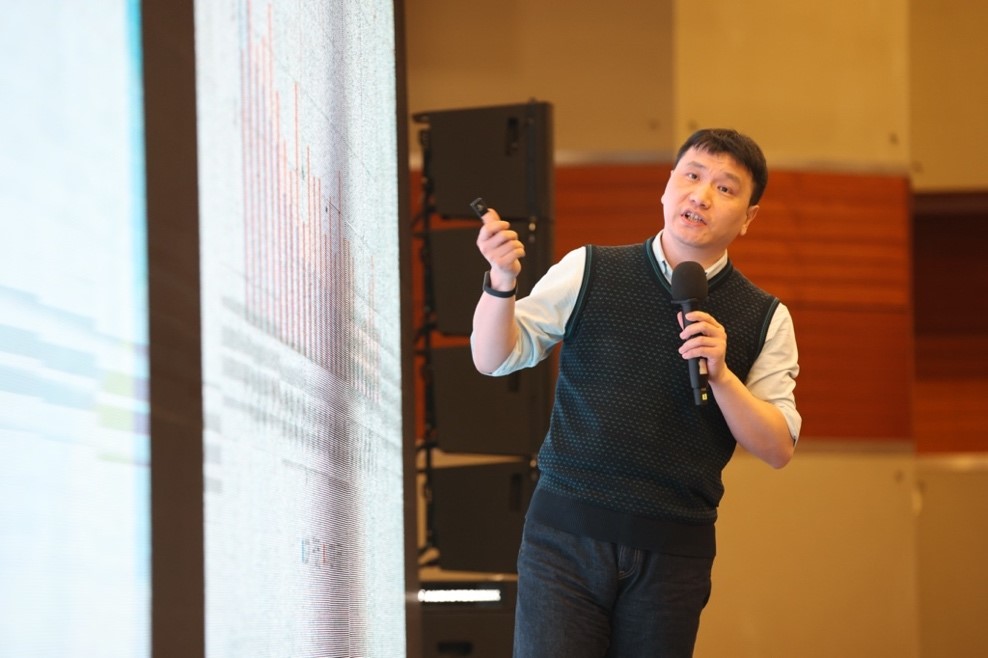
Deputy Director Luo Rong first congratulated Professor Zhuang Yumin and her team on the Report. According to LuoRong, the Report pioneers the concept of “green, innovative” development in China and has constructed an analytical framework from two dimensions ofinput on and output of green, innovative development. This Report is a groundbreaking piece of research for high-quality development of the Yangtze River Economic Belt. Moreover, Luo Rong regarded the Report as both theoretically and practically relevant.The concept of “green, innovative” development is an extension of green development andsuggests the way forward for the Yangtze River Economic Belt. This Report guides cities to improve institutions and systems, increase spending on research and development, boost infrastructure development and advance the commercialization of innovations.Luo Rong then expounded on new measures to be taken to promote the Yangtze River Economic Belt’s high-quality development in the 14th Five-Year Plan period. During this period, the philosophy of green development will be manifest in all aspects such as the economy, culture and society. Furthermore, coordinating ecological protection and high-quality development will be fundamental to the development of the Yangtze River Economic Belt.
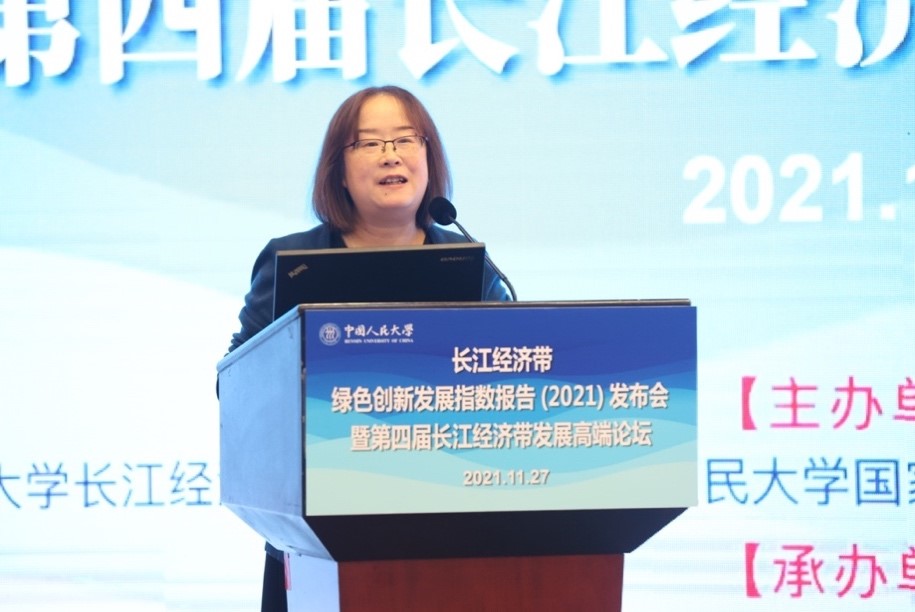
Dean Ma Wenjie believed that the compilation of the Yangtze River Economic Belt’s Green, Innovative Development Index is pioneering and significant. The Index’s emphasis on green, innovative developmentprovides guidance to both policymakers and green finance investors. According to Dean Ma, the Index is well-compiled as manifest in the following areas. First, it has a comprehensive and logical system of indicators.Second, it divides the Yangtze River Economic Beltinto the upper, middle and lower areas, for each area a unique indexhas been developed to improve its comparability. Third, the Index was compiled based on open and transparent statistics and is therefore sustainable. Dean Ma concluded by suggesting that a dimension of green finance support could be added. This new dimensionconsists of green credit, green bonds, green funds, green guarantee, among others. Moreover, emission intensity deservesan in-depth analysis to provide reference for the transformation and upgrading of the energy mix. Last but not least, policies on financial support should be incorporated into the index system.
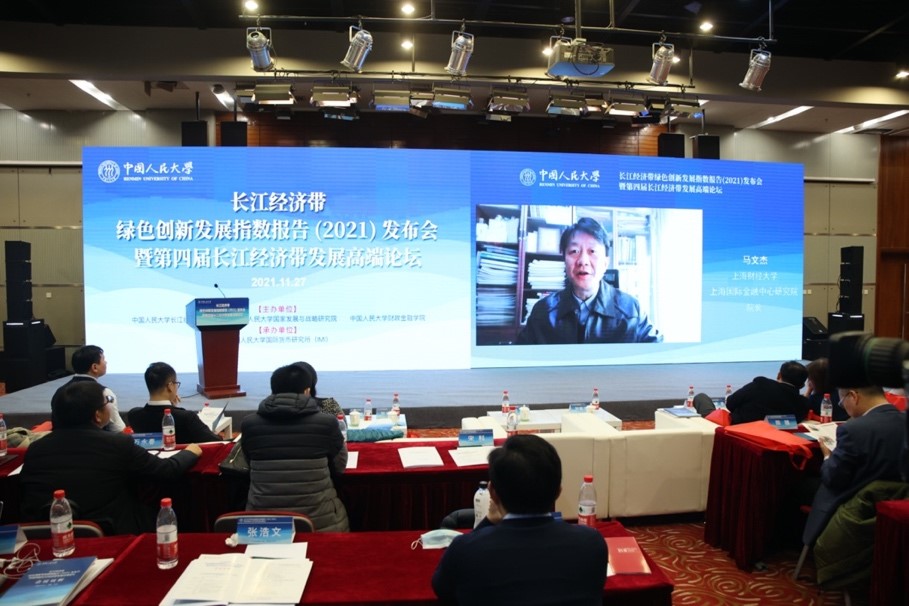
Chief Economist Zhou Yueqiu contended that the Report is of strategic significance, forward-looking in terms of its indicators, science-based in terms of its indicator system, applicable,and innovative. Hecalled attention to balanced development of the Yangtze River Economic Belt, orderly advancement in ecological civilization and green transformation of industries. He concluded with some suggestions on how to leverage green finance to promote ecological civilization and high-quality economic growth.
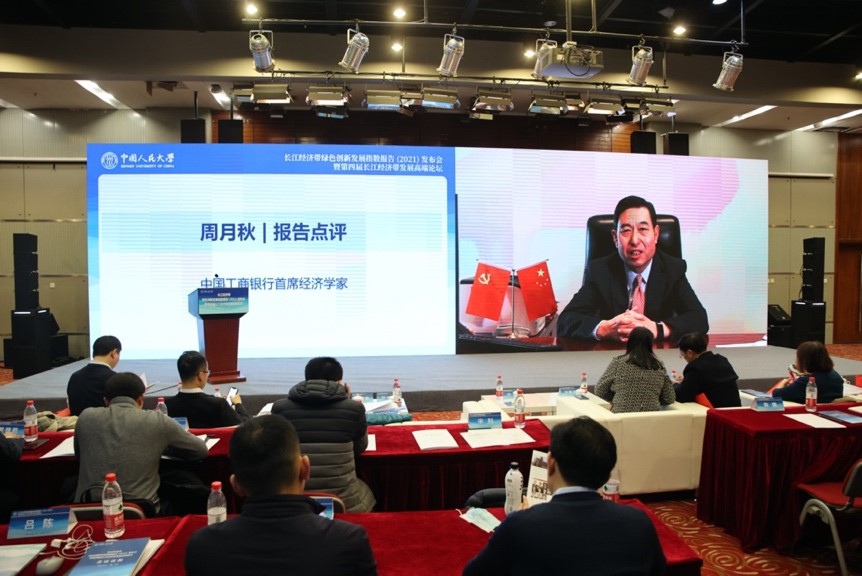
In the afternoon, two parallel forums were held.
Parallel forum one on the theme of “Yangtze River Economic Belt’sGreen Development Model and Path” was presided by Song Ke, Deputy Party Secretary of School of Finance,RUC and IMI Deputy Director. Yuan Huabing, standing member of YibinMunicipal Party Committee and Executive Vice Mayor of Yibin, Professor Lin Chen, Head of the National Academy of Development and Strategy, RUC, Xiang Yuewen, Deputy Director of the Economy Operation Bureau of Chongqing Liangjiang New Area, Mei Dewen, General Manager of China BeijingGreen Exchange and Secretary General of Beijing Green Finance Association, respectively delivered keynote speeches. Ma Wenjie, Dean of Shanghai Institute of International Finance Center of Shanghai University of Finance and Economics, Tu Yonghong, Dean of Yangtze River Economic Zone Research Institution, RUC, Zhang Zaijie, Dean of Green Development Strategy Research Institute of Western China, Guizhou University of Finance and Economics, Professor Lan Hong from School of Environment & Natural Resources, RUC, Professor Dai Wensheng from School of Finance, RUC, and Wang Peng, Deputy Director of Institute of Chinese Financial Studies of Southwestern University of Finance and Economics, were engaged in a discussion over this topic.
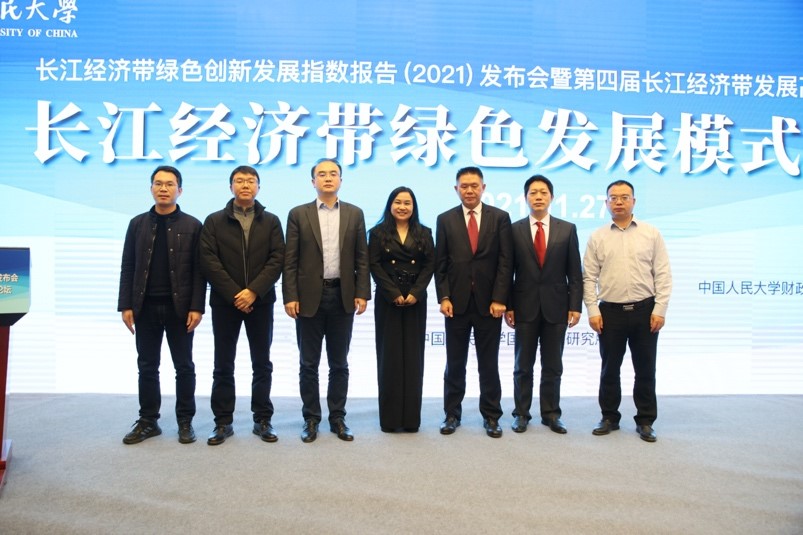
Parallel forum two on the theme of “Yangtze River Economic Belt’s Innovative Development Model and Path” was chaired by Qian Zongxin, Deputy Party Secretary of School of Finance, RUC. Ma Mingjie, Director of Research Department of Innovation Development, Development Research Center of the State Council, Zhang Chunpeng, Director at Department of Science & Technology Evaluation, National Center for Science & Technology Evaluation, Luo Laijun, Deputy Director of Policy Research Office of Hainan Provincial Party Committee and Shi Xijie, Director of National Energy Conservation Center of National Development and Reform Commission, respectively delivered keynote speeches. Later on, Chen Weidong, Dean of Academy of Bank of China, Ji Qiang, Research Fellow at Institutes of Science and Development, Chinese Academy of Sciences, Professor He Jianhong, Director of Research Center of Companies Administration Innovation, Chongqing University of Posts and Telecommunications, Cui Xisu, Senior Vice President ofBusiness Department of China Construction Bank,Professor Zhang Xiaocheng from School of Big Data Application and Economics, Guizhou University of Finance and Economics,and Associate Professor Guo Biao from School of Finance, RUC, participated in a discussion.
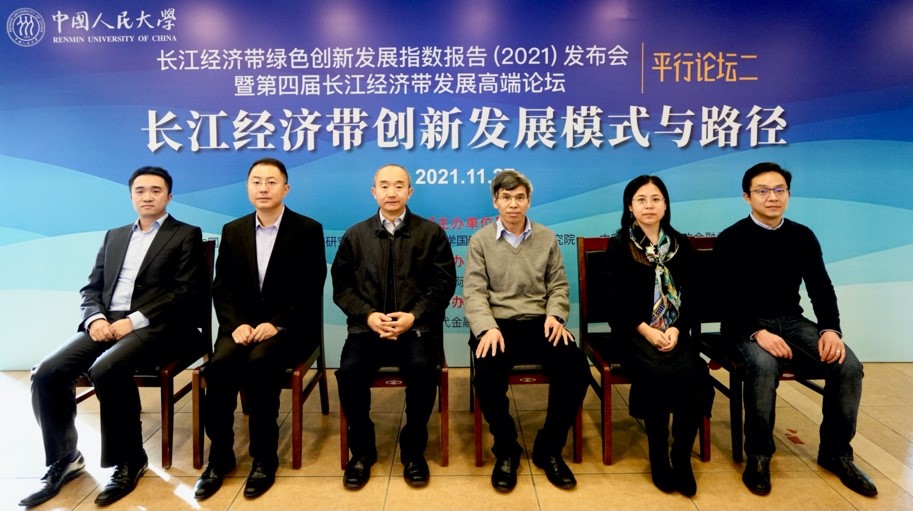
Other major participants included Chen Zhen, Senior Research Fellow at National Academy of Development and Strategy, RUC and former Party Secretary of China Institute of Finance and Capital Markets, Huang Yihai, Deputy Director of Major Strategy Planning and Development Office of Yibin, Jia Tao, Party Secretary of Science and Technology Department of Yibin, and Wan Yongchun, Executive Dean of Yangtze River Economic Zone Research Institution.
